
Consumer to consumer marketing, or C2C marketing as it’s better known, is a business model on the rise.
In our Bazaarvoice Shopper Experience Index, an annual report highlighting how shopper behaviors change across a calendar year, we discovered what might be a surprising revelation: Shoppers are your new salespeople.
So using global insights procured from the Shopper Experience Index and the latest industry research, we’ve complied this complete guide for you to get ahead of this rapidly-expanding trend.
Chapters:
- What is C2C marketing?
- Common C2C marketing techniques
- Advantages of C2C marketing
- C2C marketing examples
- How to create a consumer to consumer marketing plan
Marketing is evolving.
Just as brands and retailers had to adjust their strategies when video killed the radio advertisement, and then again when Facebook opened its platform to non .edu email addresses, today’s companies must evolve with the changing needs of their ideal customers.
But this time, it’s different.
Only a third of today’s consumers actually trust the companies whose products and services they buy. And more than 80% say brand trust (or the lack thereof) affects their purchasing decisions.
Which is why user-generated content (UGC), like customer reviews, photos, and videos, etc, has become an essential marketing tool.
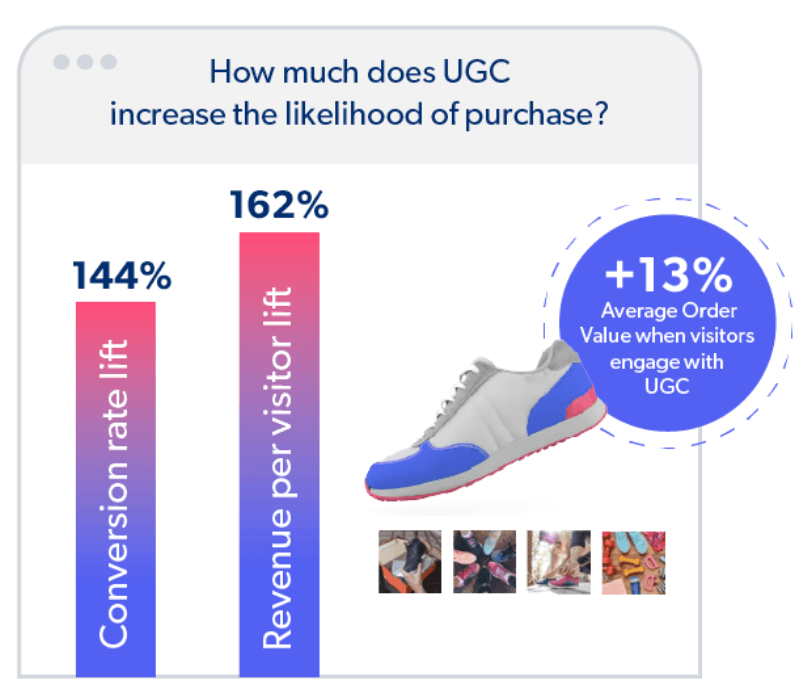
Now, consumers don’t have to rely on brands. They can rely on honest, organic content from fellow consumers to inform their purchasing decisions. Almost removing the need for branded content entirely. Almost.
Everyday, B2C industries are becoming increasingly C2B, which itself is transitioning into C2C. As Bazaarvoice CEO Keith Nealon says in his influence economy presentation, “Your brand is no longer yours.”
To further complicate issues, you’ll also need to find a way to engage customers during a period of unprecedented distrust. Today’s consumers are more critical than ever of the brands and retailers they buy from. The inequities exposed by the pandemic and related economic crises have correlated with an increased wariness of the current state of capitalism.
To succeed in today’s oversaturated market, you must find an effective and cost-efficient way to:
- Build loyalty
- Increase organic traffic
- Stand out from the competition
All while, thanks to new privacy regulations, losing access to the data-collecting tools you use every day to do just that.
Enter consumer-to-consumer marketing.
What is C2C marketing?
With consumer to consumer marketing (C2C marketing), potential customers learn about your brand and products from their peers — not your marketing team.
This can happen organically. A customer tries one of your products, is happy about the results, and shares their experience on social media, via email, or at the kitchen table.
It can also be initiated by a brand or retailer. So-called “influencers” are perhaps the most well-known (and overused) example of sponsored C2C marketing, but they’re not the only ones. More on that in a minute.
Unlike traditional marketing, where you tend to promote products directly to potential customers in a one-way dialogue, C2C marketing is more collaborative. It can also be more cost-efficient.
Even better, it’s perceived as more trustworthy than traditional marketing.
Think about the last item you bought. Chances are you took a quick glance at the images and description to make sure you were in the right place and then dug into the customer reviews. Maybe you googled the product to see what your favorite news site or blog had to say about it. You might have even searched Instagram for photos and videos of the product in action.
The company you were purchasing from didn’t sell you that product. The customers who used, enjoyed, and recommended it did.
By engaging your most loyal and enthusiastic customers to help you market your product, you’re able to develop and leverage content that builds trust in perhaps the most organic and scalable way. All while saving your team time and decreasing your reliance on third-party data.
As Tom Fishburne, founder and CEO of Marketoonist, once said, “The best marketing doesn’t feel like marketing.”
Consumer-driven or community-driven?
Depending on who you ask, C2C may mean different things to different people. “Customer to customer marketing,” “consumer-driven marketing,” or “community-driven marketing.”
All describe the process of engaging your customers and other consumers to spread the word about your product or services for you. Also known as the influence economy.
Call it what you want, but the fact remains: If you want to build trust with today’s increasingly wary consumers, C2C marketing is an important part of your promotional toolkit.
C2C, B2B, C2B: What’s the difference?
Acronyms galore here, so bear with me. While they share many of the same objectives, C2C marketing is different from other forms of advertising.
Take the traditional B2C model. Here, you’re trying to target every potential customer with ads, sponsored content, and other types of promotions. You may be able to segment your audience based on demographics, user behaviors, or interests, but you’re still casting a relatively wide net.
C2C is much more targeted. With reviews and UGC, you’re working with your current customers. Sampling programs target people who are likely to be interested in your brand. If you partner with a brand ambassador, their content will be shared with their exclusive community.
This is much less disruptive than traditional forms of marketing. It’s also better received because it comes from consumers’ networks or the people they already follow on social media.
C2B marketing
C2B marketing is not to be confused with C2C marketing, despite all of the letters they have in common. It actually stands for consumer-to-business. In this model, a user or customer provides a service to a brand or retailer. Examples include focus groups in which a company brings in a select group of customers to get product feedback or otherwise learn about their preferences. In exchange, the company might give gift cards to participants to thank them for their time.
Another example of C2B marketing is an individual providing services like writing, graphic design, or web development to a business in exchange for a set fee.
In both instances, the company and individual(s) are working together. But the user is providing a service, not actively marketing the company’s products to their community. Get it?
Common C2C marketing strategies
As aforementioned, influencers are perhaps the most well-known example of C2C marketing. But many consumers are hesitant to believe the celebrities in their feeds. In fact, some go as far as rating celebrity influencers as less trustworthy than the government.
That’s why it’s important to consider all forms of C2C marketing strategies to get the most ROI out of this burgeoning channel.
Word-of-mouth C2C marketing
For most brands and retailers, word-of-mouth marketing is the holy grail of C2C marketing. It’s organic. It requires little effort on your team’s part. It’s (technically) free. And it results in a stockpile of authentic, trust-building content.
Word-of-mouth marketing is mainly user-generated. Think of the scenario we mentioned earlier: Someone tries your product and is so happy about the results, they freely talk about it on social media. Another good example is a consumer looking to upgrade their kitchen appliances. They may go on Facebook or Twitter and ask their community for recommendations.
Both of these types of conversations can also happen offline. You may casually mention to a friend that you’ve found a new favorite shampoo. Or you may ask your friend who’s participated in three triathlons about their favorite running shoes.
Word-of-mouth marketing can also be amplified or initiated by the brand. In this scenario, a company may offer rewards, freebies, or discounts in exchange for a customer sharing their experience.
User-generated content
For most brands and retailers, the second-best thing to word-of-mouth marketing is user-generated content, or UGC.
UGC is created by unpaid contributors. It includes any type of content that promotes your brand, including written reviews, product photos and videos, and even audio, that your customers or followers create and share across their social networks and on other online platforms.
Almost three quarters (74%) of respondents in our SEI report said they find UGC important, and another 75% said they look at photos and videos from other shoppers when buying.
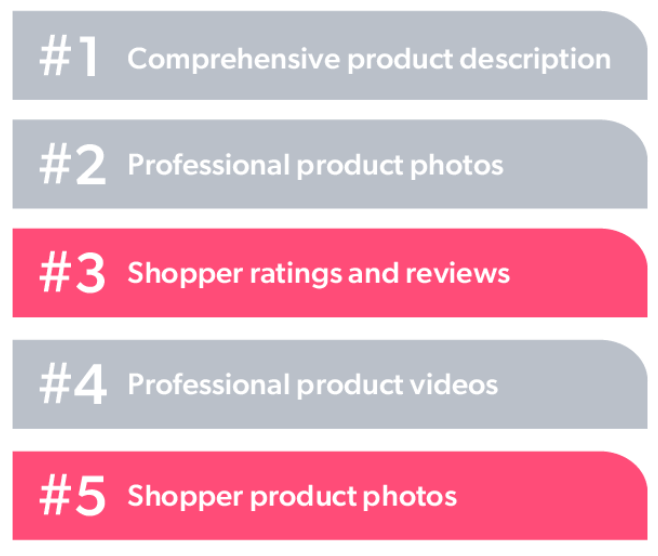
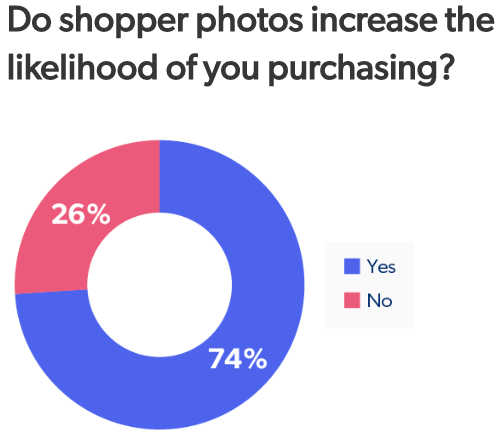
Just as a consumer is more likely to trust a friend’s recommendation than a commercial interrupting their Spotify playlist, UGC is also more powerful than traditional brand marketing.
Think of UGC as the digital equivalent of a product recommendation from a friend — even if that “friend” is a total stranger.
A whopping 85% of people consider UGC to be more influential than brand content because it showcases how actual people use products in real-world settings.
This creates a sense of authenticity, which means a lot to consumers — especially younger ones. Eighty-four percent of millennials say UGC influences their purchasing decisions. While nearly half of Gen Zers cite social media as their chief source of inspiration — even above the recommendations from family and friends.
Perhaps it’s no surprise that customer-created content receives 28% higher engagement than typical brand posts.
Ratings and reviews
The most fundamental element of UGC is customer ratings and reviews. How fundamental? Consider this chart, from our recent survey of over 30,000 members of the Influenster community:
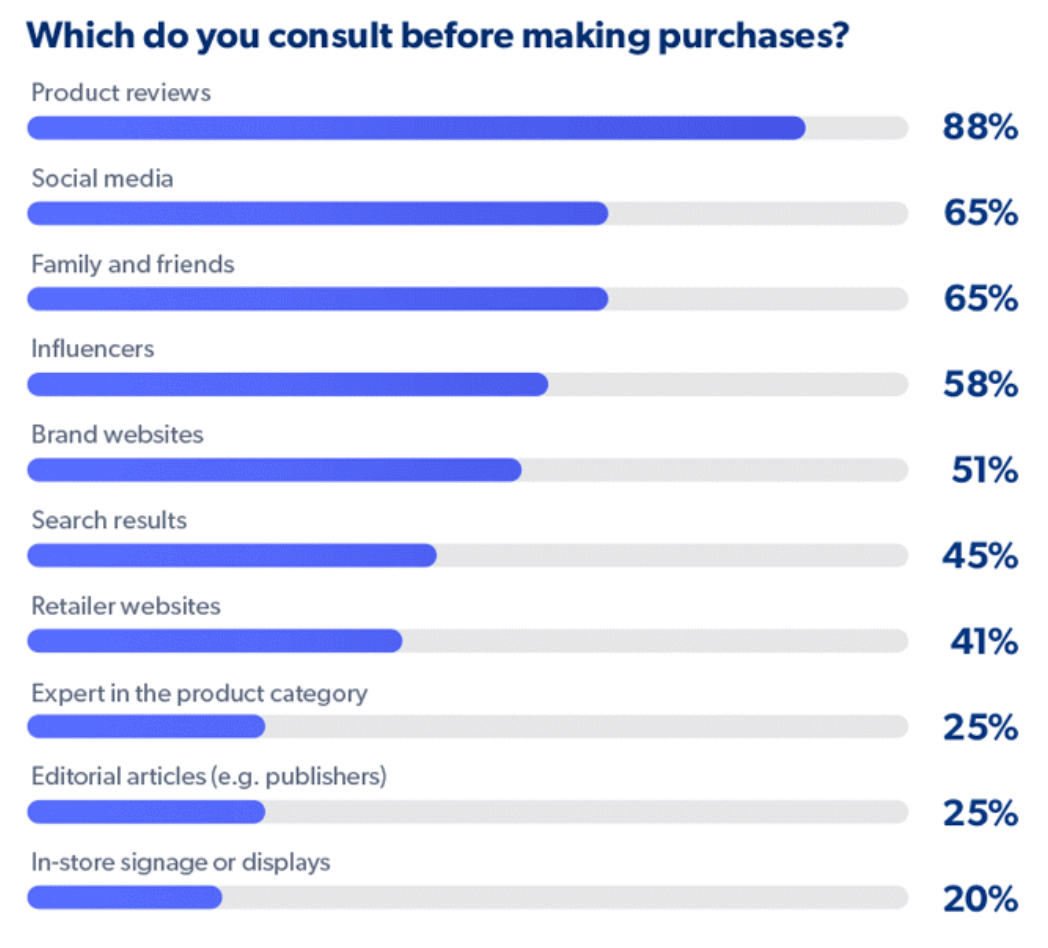
When discovering and evaluating products, 88% of shoppers turn to reviews to learn more. Even if they plan to shop in-store, 82% research products beforehand.
Ratings and reviews also help at the final decision-making stage of the buying process. 86% of consumers read shopper reviews while they’re shopping, according to our SEI report. Reviews help them feel more confident about their purchase decision and may even encourage them to buy a more expensive product, according to our research.
By actively encouraging your customers to share their experiences with your products or services, not only do you increase the likelihood of purchase, but you can solicit valuable consumer insights to use throughout your marketing funnel.
Product sampling
Sampling, as demonstrated right, is a powerful way to generate reviews and other types of UGC. In this form of C2C marketing, you send samples of your products to hyper-targeted members of your audience, either for free or for a nominal fee.
Users are encouraged to try the products and share honest feedback in return. In addition to providing valuable UGC and feedback, many samplers also turn into loyal customers.
We recently surveyed over 6,000 members of our Influenster product discovery community. Of those shoppers who took part in sampling campaigns:
- 60% said they purchased the product they sampled
- 97% purchased at least one additional item from the brand
- 87% recommended the product to friends and family
- 50% said the product eventually became a staple in their lives and routines
Collaborations with brand ambassadors
As we said earlier, consumers are over the celebrity influencers in their feeds. But they’re open to recommendations from the blogs and social media accounts they follow — as long as they seem genuine and authentic.
Like sampling programs, brands send ambassadors products that they can review and share with their community. But these arrangements are typically more structured — there may be guidelines about the amount and type of content that’s created. These programs are also typically sponsored, with the ambassador receiving compensation for their time and effort.
Depending on your needs and goals, ambassador programs can help at any stage of the buying cycle. They can create buzz about your brand or help drive conversions. These arrangements are typically set up so that you own all of the content the ambassador creates, allowing you to repurpose their videos, posts, and photos as needed.
Affiliate and referral programs
The final most common type of C2C marketing is affiliate programs. Here, users sign up to promote your products or services on their social networks and website.
Depending on the arrangement, they get paid or otherwise credited when a user clicks on their links and either buys a product, signs up for a newsletter, or completes another action designated by the brand.
Advantages of C2C marketing
C2C marketing has multiple advantages over traditional brand promotions.
Build consumer trust
Because the content is generated by actual users, it’s deemed more trustworthy than marketing campaigns that start in the company boardroom. It’s a powerful form of social proof that validates the claims you make in your marketing and product messaging.
With consumer trust levels at all-time lows, this is perhaps the most important benefit.
Consider this stat: 92% of people trust product recommendations made by people (even total strangers!) over those made by brands.
Save time and money
When done correctly, C2C marketing campaigns can save your internal team tons of time, money, and headspace. That’s because the responsibility of creating all of those photos, blog posts, and videos falls to your customers, not your marketing team.
Even better, this content can be reused on multiple marketing platforms, from your social media channels to your website to your email campaigns. You can also create a database of UGC that can be repurposed throughout the year. (As long as you have permission from the creator, of course. We’ll walk you through that in a second.)
Depending on the arrangement, you might have to send free samples or pay the user for their time. But generally, the ROI of these programs is more than worth it.
Generate leads and conversions organically
When people share content about your brand on their personal platforms, your brand is suddenly front and center on the feeds of all of their friends, family, and acquaintances.
This kind of exposure helps increase your brand awareness and name recognition. For customers who are already familiar with your brand, a glowing review or user-generated video can be the final encouragement they need to make a purchase.
Want proof? 53% of consumers say UGC makes them more confident in their buying decision than professional photography (47%).
It’s future-proof
With Google and Apple rolling out changes that limit your access to consumer data, a C2C marketing campaign can help you better target your ideal customers, without having to rely on cookies or third-party analytics.
By working with ambassadors and affiliates whose audience matches your customer profiles, you can get in front of the very people you want to target and build a first-party data strategy — no third-party required.
Increase your social media presence
In addition to providing valuable content that you can reshare on your social media channels, you also get a social boost when users tag you in their posts. This helps drive more people to your social media profiles, where they can see additional content that pushes them further down the sales funnel.
Even if they’re not ready to buy, they may visit your site, download your lead magnets, or sign up for your newsletter.
C2C marketing examples
Below are some of the biggest brands on the globe putting some of the above tactics to perfect use.
Vertbaudet: Acting on UGC consumer insights
Baby and maternity brand Vertbaudet knows the importance of customer reviews. Not just for convincing prospective shoppers to make a purchase, but for their valuable source of consumer insights.
For example, the brand noticed multiple customers leaving reviews saying that a particular dress was too small. So in response to this feedback, Vertbaudet reassessed the measurements of the dress and amended the cut.
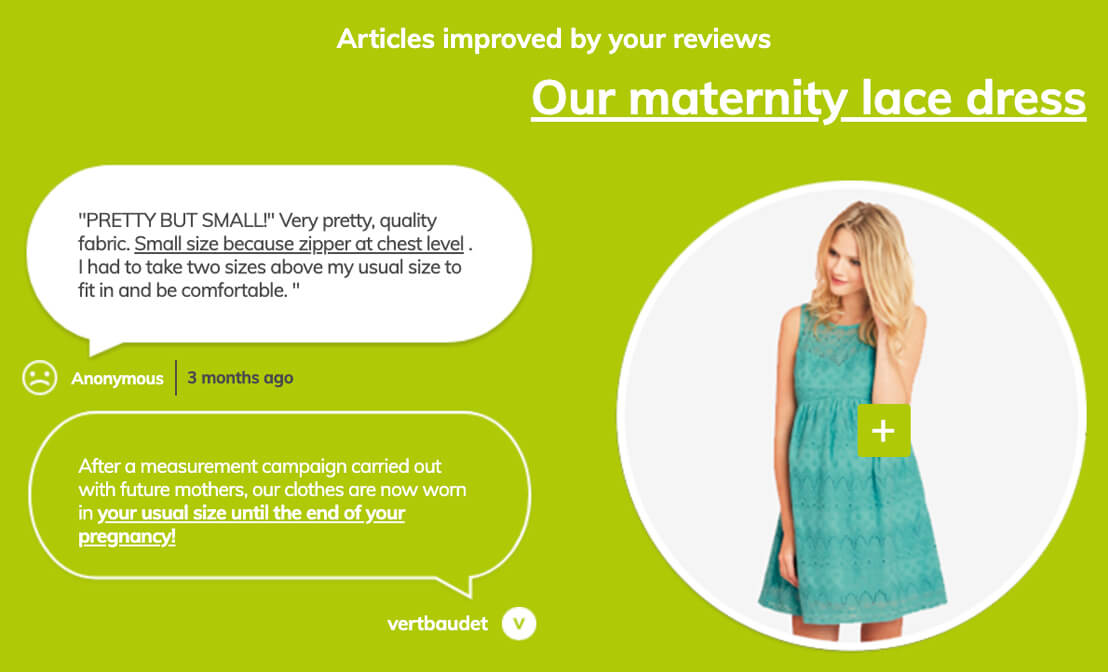
This led to a 12% increase in sales among customers who read reviews, for what was frankly an easy solution. Feedback is already there, you just have to read it. And of course, react to it.
Coca-Cola: Amplified word-of-mouth marketing
In 2012, Coca-Cola installed “Happiness Machines” in various cities around the world. Customers could get a free Coke by interacting with the machines, hugging them, or dancing around them — all great fodder for potentially viral social media content.
To take it even further, the Happiness Machines also doubled as phone booths. Customers could make free calls in exchange for their Coke bottle caps.
This amplified word-of-mouth marketing campaign was so successful and engaging, it won Coke multiple awards.
Crocs: UGC superstars
Crocs has become a TikTok superstar. By encouraging customers to create Crocs-related videos and tag them with the branded #croctok hashtag, the shoe brand created an avalanche of UGC.
These videos of people cleaning, decorating, and simply enjoying their new shoes sparks interest and excitement while capturing brand loyalty. It also generates a ton of content that Crocs can use throughout its marketing funnel.
Sweatblock: Reviews in search results
In addition to converting customers who are already on your page, reviews can also be used throughout the buying cycle.
You can share them on social media and in cart-abandonment emails. You can also promote them in Google search results. This helps you convince people who are in the very early stages of the consideration phase to trust your product or brand.
Clarins: Sampling for success
How do you get all of those glowing reviews? Sampling programs!
To boost sales of its anti-aging product line, the beauty brand Clarins launched a sampling campaign to get products into the hands of consumers in exchange for their feedback.
The responses exceeded its initial expectations. More than 90% of those who received a sample wrote a review, an 11% higher rate than the company’s initial goal.
In just over a month, the company received a striking 138 reviews, all of which provided the depth of insight needed to persuade customers to purchase the brand’s high-end products.
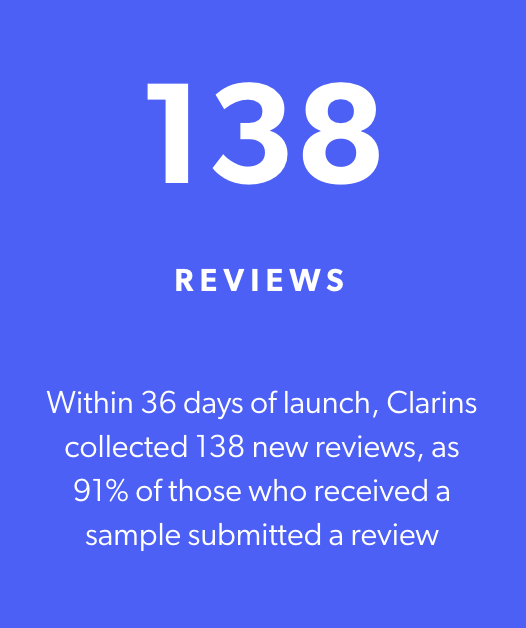
The rich, detailed reviews helped Clarins increase its conversion rates by 111%.
Red Bull: Brand ambassadors on campus
To boost sales of its energy drink in college towns and communities, Red Bull employs a team of “Student Marketeers” on campuses around the country.
These Marketeers are tasked with developing and executing marketing and sales plans in their respective territories. This could include hosting events, developing sponsorship programs, and other guerrilla marketing programs.
According to Glassdoor.com, these Marketeers are paid an average of $14/hour.
Affiliate inspiration and resources
Everyone from Amazon to Etsy to Home Depot offers affiliate programs.
Click the links above to learn more about each company’s program. You might just be inspired to start your own affiliate network. You can also partner with services like Awin, impact.com and CJ to partner with their network of creators.
How to create a C2C marketing plan
1. Find your audience
The most critical element of a successful C2C marketing campaign is people. Ideally people who enjoy using your product, have a need for it, or who are somehow directly or indirectly connected to your brand or vertical.
While it may be tempting to gravitate toward users with large social media followings, that’s not the most important factor. Instead, you want to work with people who have genuine relationships with their followers. You also want to find people who know how to create engaging and meaningful content.
Depending on your brand’s marketing efforts to date, you may be able to find your ideal partners among your current fans, followers, and email subscribers. Or, if you’re relatively new to your vertical, you may have to contact potential partners directly.
You can also work directly with services that help you set up sampling and UGC campaigns and do all of the hard work for you. (Cough, cough, like Bazaarvoice.)
2. Make it about them
Whether you pitch to creators directly or host a contest among your followers to find your next brand ambassador, you want to make sure you’re always stressing how the arrangement benefits them.
For example, they get free products and they get to help their followers make informed decisions.
If you’re contacting potential collaborators, be sure to compliment them and elaborate on why you like their brand and think they’d make a great partner.
3. Get it in writing
Make sure both parties are clear on the expected deliverables, milestones, and deadlines, and who retains ownership of the content. While you should never pay for honest and authentic reviews, some deliverables will require a lot of work on the users’ part. You may have to compensate them for their time and effort.
4. Watch and learn
Creating a branded hashtag for the campaign can help you track the posts, shares, and overall engagement rates of the program. Store all of this content in an easy-to-access place so you can repurpose it for future use.
Take notes of what’s working and what’s not. Determine the metrics that matter (for example: website traffic, time spent on your site, engagement rates, etc.), and track them accordingly. This will only help you perfect future C2C campaigns so you can build more trust with potential customers.
Now’s the time for C2C marketing
There’s never been a better time for brands and retailers to authentically engage with their community. Consumers can easily go online and share their experience with your brand, positive or negative. So give them a good experience.
By creating a community around your brand, you’re not only able to cultivate the trust that drives sales, you’re also able to give customers a moment of joy and a sense of belonging — which for many brands and retailers is just as important as profits.
The best way to get started on your C2C marketing strategy? By becoming an expert in all things UGC. Learn everything you need to know with our complete guide to user-generated content. Or catch the webinar version here instead.
You can check out the rest of our Long Read content here for more marketing strategies, tips, and insights.




